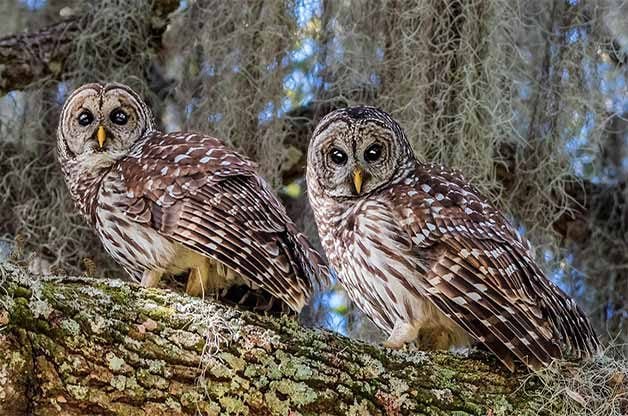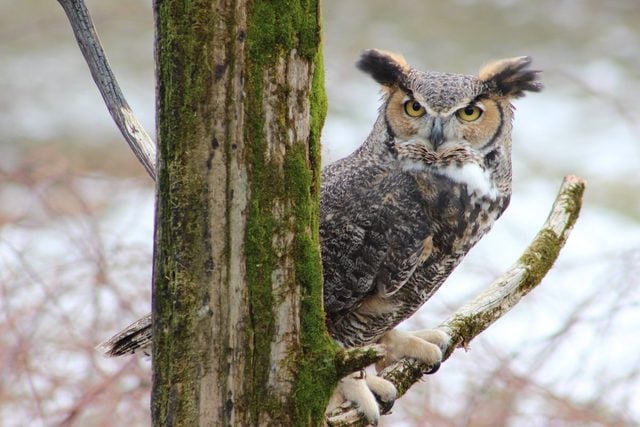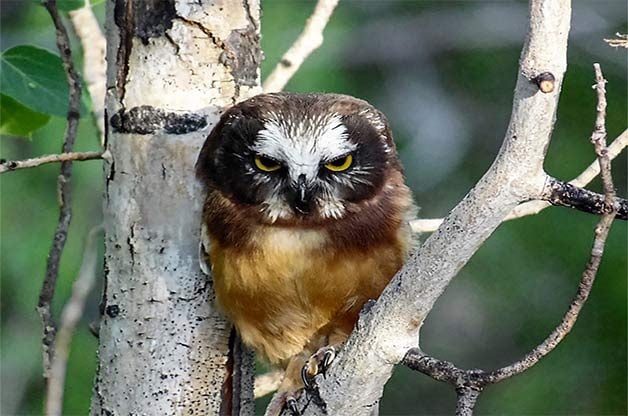Spot the Owl in Your Backyard Trees
Updated: Jan. 19, 2021
Be a bird sleuth and discover who's flying through the neighborhood. Here are the telltale signs you should look for if you want to spot owls in the trees.
If you’ve never seen an owl in your backyard, that doesn’t mean one isn’t there. These mysterious birds are nocturnal predators, so they hunt in the darkness after you’ve gone to bed. Their special feathers allow them to fly in complete silence, making owls even more difficult to hear than they are to spot in trees. Put on your detective’s cap and become a sharp-eyed owl observer.
How to Spot Owls in Trees

To spot an owl, stay up late and do some nocturnal wildlife-watching from the comfort of your deck or on your next camping trip. As human activity dies down for the evening and the smaller animals that owls prey on become active, you are more likely to spot one of these nighttime birds. Binoculars are a must for owl observation, and if you’re a birder, you probably have a set handy. If you don’t own a pair yet, there are plenty of high-quality, beginner binoculars to get you started.
Thanks to excellent camouflage, owls are still able to fly under the radar once the sun comes up. If you move quietly and scan patiently, you may be able to spot an owl on its daytime roost. Owls often roost in dense evergreens. They’ll also perch close to the trunk in other kinds of trees, where they’re easier to spot once autumn leaves fall. Some species roost inside tree cavities, and you may be able to spot them looking out of the holes on warm days.
Learn more about the owls of North America, your noctural neighbors.
Listen for Owl Sounds

Even though it’s unlikely you’ll hear one of these birds of prey flapping its wings because of the silencing flight feathers, your ears are still some of your best tools for discovery. Owls can be quite vocal, and like other bird groups, different species have different calls. Owls in towns and cities are often less vocal than those in wild country. But late at night, after traffic quiets down, listen for them calling. Whether it’s the who-cooks-for-you of the barred owl, the ghostlike trilling of a screech-owl or the bold, classic hooting of a great horned owl, learning owl sounds and calls is one of the best things you can do to find more species in your neighborhood. Get your owl know-how rolling with the Cornell Lab of Ornithology’s website, allaboutbirds.org, which includes calls for each species and is a great educational resource for all types of identification.
Don’t miss these outstanding pictures of owls.
How to Find Owl Pellets and Feathers

Beyond sight and sound, there are plenty of other ways to notice when an owl might be nearby. Like all birds, they molt their feathers and grow a new set every year. Be on the lookout for large feathers on the ground, and have a field guide handy to match your find with the correct species.
Owls also produce pellets—little balls of hair and bone that they regurgitate. Owls often swallow their food whole, later coughing up the indigestible parts. You may find owl pellets of matted fur, tiny bones, and insect scales under dense evergreens where the owls have roosted. These remainders are sure signs that owls are around. Scour the ground beneath trees for owl pellets, and if you’re really feeling adventurous, take one apart to learn what the owls in your neighborhood have been eating for dinner.
Additionally, once owls find a roosting spot, they may use it for several days. Their droppings accumulate as “whitewash” on the ground or on the tree trunk below their perch.





















